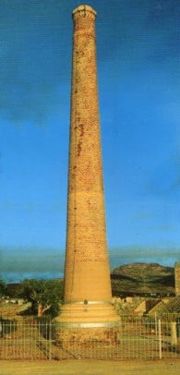
Okiep, Northern Cape
Encyclopedia

Northern Cape
The Northern Cape is the largest and most sparsely populated province of South Africa. It was created in 1994 when the Cape Province was split up. Its capital is Kimberley. It includes the Kalahari Gemsbok National Park, part of an international park shared with Botswana...
province of South Africa
South Africa
The Republic of South Africa is a country in southern Africa. Located at the southern tip of Africa, it is divided into nine provinces, with of coastline on the Atlantic and Indian oceans...
, and was in the 1870s ranked as having the richest copper mine in the world. The town is on the site of a spring that was known to the Nama people as U-gieb ("brackish spring"), hence the name "Okiep".
History
Early settlers in the Cape ColonyCape Colony
The Cape Colony, part of modern South Africa, was established by the Dutch East India Company in 1652, with the founding of Cape Town. It was subsequently occupied by the British in 1795 when the Netherlands were occupied by revolutionary France, so that the French revolutionaries could not take...
heard rumours of mountains in the north-west that were fabulously rich in copper. Governor Simon van der Stel
Simon van der Stel
Simon van der Stel was the last Commander and first Governor of the Cape Colony, the Dutch settlement at the Cape of Good Hope in South Africa.-Background:...
was inclined to believe these tales when, in 1681, a group of Namas visited the Castle
Castle of Good Hope
The Castle of Good Hope is a star fort which was built on the original coastline of Table Bay and now, because of land reclamation, lies nearer to the Cape Town city centre in South Africa.-History:...
in Cape Town
Cape Town
Cape Town is the second-most populous city in South Africa, and the provincial capital and primate city of the Western Cape. As the seat of the National Parliament, it is also the legislative capital of the country. It forms part of the City of Cape Town metropolitan municipality...
and brought along some pure copper. Van der Stel himself led a major expedition in 1685 and reached the fabled mountains on 21 October. Three shafts were sunk and revealed a rich lode of copper ore - the shafts exist to this day. For almost 200 years nothing was done about the discovery, largely because of its remote location. The explorer James Alexander
James Edward Alexander
Major-General Sir James Edward Alexander KStJ was a British soldier, traveller and author.-Background:Born in Clackmannanshire, he was the eldest son of Edward Alexander and his second wife, daughter of John Glas...
was the first to follow up on van der Stel's discovery. In 1852 he examined the old shafts, discovered some other copper outcrops and started mining operations. Prospectors, miners and speculators rushed to the area, but many companies collapsed when the logistical difficulties became apparent.
The first miners were Cornish
Cornish people
The Cornish are a people associated with Cornwall, a county and Duchy in the south-west of the United Kingdom that is seen in some respects as distinct from England, having more in common with the other Celtic parts of the United Kingdom such as Wales, as well as with other Celtic nations in Europe...
, and brought with them the expertise of centuries of tin-mining in Cornwall
Cornwall
Cornwall is a unitary authority and ceremonial county of England, within the United Kingdom. It is bordered to the north and west by the Celtic Sea, to the south by the English Channel, and to the east by the county of Devon, over the River Tamar. Cornwall has a population of , and covers an area of...
. The ruins of the buildings they constructed as well as the stonework of the bridges and culverts of the railway built to transport the ore to Port Nolloth
Port Nolloth
Port Nolloth is a town and domestic seaport in the Namaqualand region on the northwestern coast of South Africa, 89 miles northwest of Springbok....
, can still be seen. This narrow-gauge railway started operating in 1876 and lasted for 68 years, carrying ore to Port Nolloth and returning with equipment and provisions. The carriages were initially pulled by mules and horses, which were later replaced by steam locomotives - the last of these, the Clara, stands at Nababeep. Nowadays road transport is used to convey the ore to the railhead at Bitterfontein. The other principal mines of the area are at Carolusberg and Nababeep.
Okiep’s mine saw action on 4 April 1902 during the Anglo-Boer war when some 700 officers and men of the 3rd Battalion Queen's Royal Regiment, 5th Royal Warwickshire Regiment, Namaqualand Border Scouts, the Town Guard and the Cape Garrison Artillery
Cape Garrison Artillery
The Cape Garrison Artillery is an artillery regiment of the South African Army. There have been two regiments of the name: one a coast artillery regiment, the other an anti-aircraft regiment. The latter is part of the South African Army Artillery Formation.-1859-1866:The forerunner of the...
, withstood a 30-day siege by Jan Smuts
Jan Smuts
Jan Christiaan Smuts, OM, CH, ED, KC, FRS, PC was a prominent South African and British Commonwealth statesman, military leader and philosopher. In addition to holding various cabinet posts, he served as Prime Minister of the Union of South Africa from 1919 until 1924 and from 1939 until 1948...
’ forces. The village of Concordia with a garrison of 100 men, surrendered a day after the siege started. On 4 May 1902 a British relief column arrived from Port Nolloth and ended the siege. A ruined blockhouse is still visible on a hill north-east of the town.


